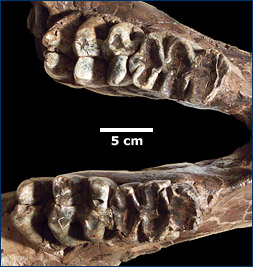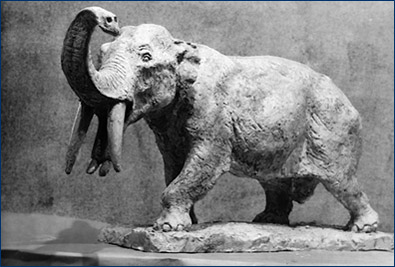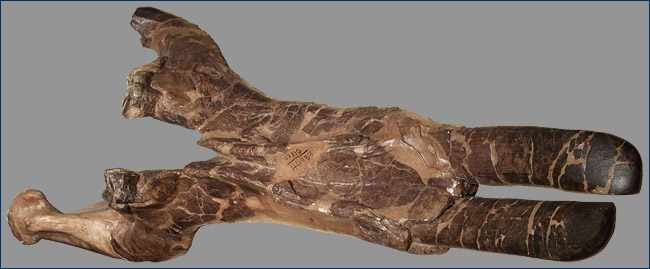
The Gomphotheriidae
Gomphotheres
Gomphotheres were large proboscidean mammals that had global distribution (except for Antarctica and Australia) during the Miocene, Pliocene and Pleistocene. Together, they represent the stem group of stegodontids and elephants, forming a paraphyletic group. They had four tusks — two upper and two lower — that were oval and sometimes round in cross section. Their upper tusks were curved both downwards and outwards, while their lower tusks were progressively spatulate-shaped and lacked enamel. Their molars were bunodont, similar to those of mastodons. Some gomphotheres were trilophodont like the mastodon Trilophodon while others were tetralophodont like elephants and stegodontids.
Gomphotheres arrive on the scene during the Miocene, at which time they already had a cosmopolitan distribution. Early fossils have been found in East Africa, Europe, Japan and China, all from the early Miocene. These early gomphotheres are part of an old world ancestral group called the Gomphotherium "annectens group," characterized by their simple molars. Species in the group include G. annectens, G. cooperi, G. sylvaticum and an unidentified species from East Africa. The systematics and phylogenetic relationships within gomphotheres and how they fit into the phylogenetic tree of Proboscidea is still unclear and ongoing research is trying to clarify the evolutionary history of the group. In the past, specimens that could not be placed in Elephantidae or Stegodontidae were placed in Gomphotheriidae resulting in a paraphyletic group. A phylogenetic study of 19 gomphotheres (Shoshani 1996) concluded that 15 belonged to the same clade, however, this clade was not strongly supported.
The evolution of gomphotheres, along with stegodontids, is considered the second radiation of Proboscidea (after the ancestral radiation). Migration of proboscideans, including gomphotheres, out of Africa and into Asia and Europe began in the early Miocene (~22 mya). This invasion is called the "Proboscidean Datum Event." Gomphotheres migrated into North America from Asia several times via the Bering land bridge, beginning in the middle Miocene and on into the Pleistocene. New World gomphotheres include Rhynchotherium, Eubelodon, Notiomastodon, Cuvieronius, Haplomastodon, and Stegomastodon. Gomphotheres also migrated to South America during the Pleistocene. Gomphothere diversity peaked during the late Miocene (~7–10 mya), but by the end of the epoch, their diversity and abundance had decreased. Still, it wasn't until the Pleistocene that the gomphotheres went extinct.
Best classified as opportunistic browsers, gomphotheres probably preferred savanna landscapes over forested or grassland areas.
 |
 |
|
 Top left: The dentition in the lower jaw of Gomphotherium. Top right: A sculpture of Gomphotherium simpsoni made by William Gordon Huff for UCMP's exhibit at the 1939-1940 Golden Gate International Exposition on Treasure Island. Bottom: The same Gomphotherium jaw as shown in the top left photo, with its relatively short, spatulate-shaped tusks. |
||
New content researched and written by Kaitlin Maguire, 11/2010; gomphothere dentition and jaw photos by Dave Smith; gomphothere sculpture photo from the UCMP archives